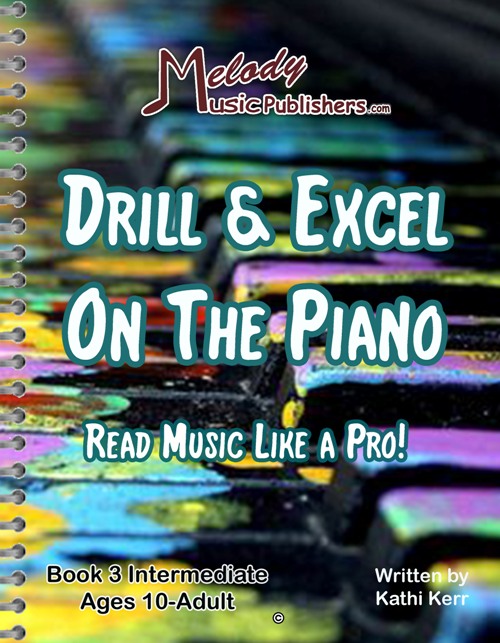Are piano method books needed for the intermediate students? Most intermediate-level piano method books are merely repertoire for the student to play. But is there more for the intermediate student? Tip #9 are the information and skills the intermediate student should learn.
What do beginning piano method books teach?
Beginning-level piano method books primarily teach keyboard geography, note reading, a little rhythm, diatonic intervals up to a 5th, and the I, ii, IV, and V7 triads. After finishing levels 3 or 4, most students can read music reasonably well and identify the intervals and the triads. However, there is more for the intermediate student to learn beyond just playing songs.
Watch our video
More for the beginning student?
First, let’s start with the beginning-level books. Here’s what you’ll find in “Drill & Excel On the Piano Book 1” from Melody Music Publishers that you won’t find in most beginning-level method books:

- Rhythm Drills for the whole, half, dotted half, quarter notes, and the rests with multiple rhythm drills
- “Rhythm is the most neglected part of most method books, even at the beginning level. Most piano method books only show the note’s value. However, simply knowing the value doesn’t create a sight-reading skill. Playing rhythm drills where the student plays and counts aloud (using a metronome) on one note is needed to read rhythm fluently”.
- Theory
- notes in order on the staff with multiple note reading worksheets
- C scale hands separate, then hands together for one octave, then multiple octaves (I have found even beginners are capable of playing scales in multiple octaves)
- Exercises
- multiple 5-note patterns (most instructors will add a book like Hannon for exercises; however, it uses a 6-note pattern, which can be difficult for a beginner)
- Staccato exercise – I’ve never seen this unique exercise in any method books, but it is an important skill to learn
- Independence of hands playing different dynamic levels and staccato/legato in each hand simultaneously using motor movement skills
- Multiple notes exercise learning to play 2, 3, and 4 notes together.
- Dynamic exercise for learning control in playing with different volumes and velocity (firmness) of the key – This is another unique drill that is critical to learning to play with dynamics.
- 60 original songs in the C position to create a sight-reading skill in this position
Easy to follow steps
After book 1, the first chapter reviews the previous books so that the intermediate student can start with books 2, 3, or 4 without missing essential information needed.
The late beginner/early Intermediate Student
Here is what you’ll find in book 2 for the early intermediate student not found in most method books:

- Rhythm drills for the eighth note and rest, dotted quarter note (explaining the formula for the dot), the tie, and the 6/8 meter
- Theory
- G and D scales in multiple octaves
- remaining notes on the staff with multi worksheets
- diatonic intervals from 2nds through the octave with multiple worksheets for learning at sight (this helps in sight-reading)
- dynamic markings and musical symbols, including the pedal and a drill for how to use it
- Exercises
- intermediate level exercises played at a faster tempo
- grace note exercise teaches how to play the grace notes with a quick and light touch
- diatonic interval drills using every finger combination – this unique drill teaches the student how to “feel” each interval with every possible fingering without looking and prepares the student to play songs outside the 5-note hand position
- 60 original songs in the keys of the scales taught
The mid-intermediate Student
Here is what’s included for the mid intermediate student in “Drill & Excel On the Piano Book 3” not found in most method books:

- Rhythm drills for the sixteenth note and rest, dotted eighth, and the eighth, sixteenth, and quarter triplets
- Theory
- major scales A and F in mulitple octaves
- minor scales Am, Em, Bm, F#m, and Dm
- explanation of relative minor scales and accidentals
- chromatic scale
- whole and half steps
- chromatic intervals and how to name them
- the four kinds of triads
- three kinds of minor scales
- Picardy 3rd
- dissonance and resolution
- phrases
- Exercises
- finger pedaling to learn how to hold one note while playing other notes simultaneously
- embellishment exercise needed when playing Baroque and classical style music
- left-hand drills show the typical left-hand movement to play without looking
- chromatic intervals with every finger combination – this repeats the previous diatonic intervals, except for playing the chromatic intervals, which completes EVERY finger combination when moving from one note to another
- chromatic scale
- consecutive 3rds – this is a challenging drill that is essential for playing intermediate and advanced level repertoire
- arpeggios – which are great as a drill and to learn all the triads’ inversions
- repeated notes and held notes while changing fingers – this is an essential skill to fingering
- left-hand bass jumps without looking – this skill is needed when the left-hand moves from bass note to chord
- 60 original songs in the keys of the scales taught
Repertoire
Choosing a repertoire for the intermediate student has its challenges, whether using a method book or not. You want to make sure it’s the right level, not too challenging or too easy, and interesting for the student. Using the “Drill & Excel On the Piano” series is easy because the songs are specifically written for the chapter’s level, skill, and information taught. No more wondering if the repertoire is the right fit for the intermediate student. And the songs are written in various styles, giving the student exposure to them, from classical, pop, ragtime, jazz, and folk styles. When the student plays songs using what they’ve just learned, it creates deeper learning and understanding.
Late Intermediate Student
And finally, for the late intermediate student in “Drill & Excel On the Piano Book 4”, here is what you’ll find:

- Rhythm – odd meters and counting the 6/8, 9/8, and 12/8 in big beats, triplets with 2 against 3 and 3 against 4
- Theory
- Scales B flat, E flat, G minor, and C minor
- triad numbers for major and minor keys
- improvisational tools
- music terminology
- circle of 5ths
- adding the 7th, 2nd, sus 4th, and 6th to triads
- blues scale
- 7th chords up the scale.
- Exercises
- working on the 4th and 5th fingers, which are the weaker fingers
- playing multiple notes while holding a note (a great skill needed for intermediate and advanced repertoire)
- independence of fingers when you want one or more notes played louder than the others within one hand
- thumb exercise
- dominant 7th arpeggios, which is another arpeggio exercise for both skill and learning the dominant 7th chords around the circle of 5ths
- 60 original songs in the keys of the scales taught
Go to the next level!
Everything is taught in an organized, step-by-step way that anyone can learn. Finally, there are piano method books for intermediate students that will help them excel to the next level!
I hope this tip makes you the BEST music teacher ever!


